The 120-Cell
The 120-cell is a beautiful object composed of 120 dodecahedra, joined 3 to an edge, meeting at 720 pentagons, 1200 edges, and 600 vertices. It is the equivalent of the 3D regular dodecahedron. It is the dual of the 600-cell.
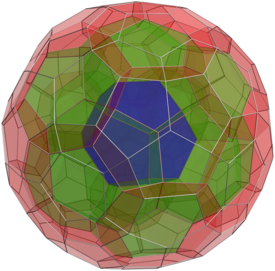
Structure
Although the sheer number of cells in the 120-cell may seem quite daunting, its structure is not extremely difficult to understand. We will explore it by looking at its cell-first parallel projection into 3D.
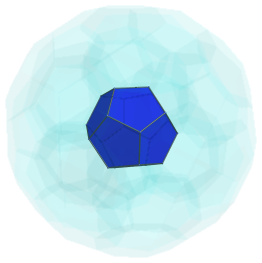
In this projection, the nearest cell to the 4D viewpoint lies in the center of the image, and may be regarded as the “north pole cell”. This cell is shown here in blue. For the sake of clarity, we only show the edges that lie on this cell, and render all the other cells in a transparent color.
On the far side of the 120-cell, directly opposite this cell, is the “south pole cell”, not shown here.
Next, surrounding this north pole cell, are 12 dodecahedra, shown in various shades of green in the following image:
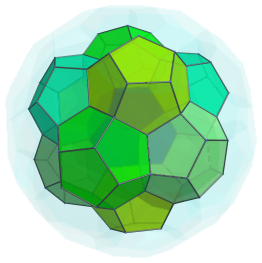
These cells may be regarded as the “arctic circle” cells. They lie directly “south” of the north pole cell. Since in 4D we have an additional degree of freedom, this “arctic circle” is really an arctic sphere, one among the many parallel “latitude spheres” that gird the 4D hypersphere. The 120-cell approximates a 4D hypersphere, just as the dodecahedron in 3D approximates a 3D sphere.
Looking closely at the image above, we see that there is a slight depression formed by each circle of three green cells, where other dodecahedral cells may fit into. The vertex in the middle of each depression is connected by an edge to a corresponding vertex on the blue north pole cell. Hence, there are 20 such depressions where the next layer of cells will fit into.
The next image shows the 20 dodecahedra fitted into these depressions.
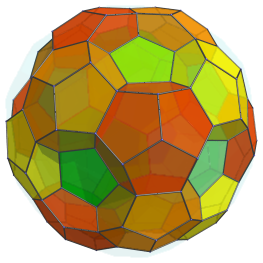
These 20 dodecahedra are joined to each other in a mesh that has dodecahedral symmetry. They may be regarded to be “middle latitude” cells in the “northern hemisphere” of the 120-cell. Together with the arctic cells, they now form 12 more pits overlying the faces of the original north pole cell, where another layer of 12 dodecahedra can fit into.
The next image shows the next 12 cells fitted into these pits:
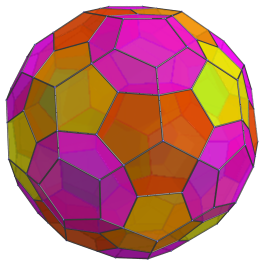
These dodecahedra lie touching the “equator” of the 120-cell. They may be regarded as the “low latitude” cells in the northern hemisphere of the 120-cell. These cells together with all the previous cells are the cells that lie on the “northern hemisphere” of the 120-cell.
Of the 6 outer faces visible here of each of these low latitude cells, the middle face lies on the equator itself, whereas the other 5 actually curve away from the equator. Those faces, together with the exposed faces of the previous layer of 20 dodecahedra, are connected to a layer of 30 more cells which lie on the equator of the 120-cell.
The next image shows these equatorial cells:
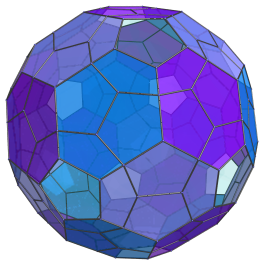
These equatorial cells correspond with the 30 edges of the original north pole cell, and lie exactly halfway between the north pole cell and the south pole cell, at the point where the 120-cell starts folding back inwards towards its south pole. As such, they lie at an angle of exactly 90° with the viewpoint, and so appear to be flat. In reality, however, they are perfectly regular dodecahedra. For clarity, we have omitted the cells in the preceding layers.
After this point, the layers we have seen before now repeat in reverse. The visible pentagonal gaps in this image are where the low latitude cells of either hemisphere touch each other. There are 12 low latitude cells in the southern hemisphere, surrounded by 20 mid-latitude cells. Below these are the 12 cells in the “antarctic sphere” of the 120-cell. Finally, surrounding these antarctic cells is the south pole cell.
So, in summary, we have 1 north pole cell, 12 arctic cells, 20 northern mid-latitude cells, 12 northern low-latitude cells, 30 equatorial cells, 12 southern low-latitude cells, 20 southern mid-latitude cells, 12 antarctic cells, and 1 south pole cell, for a grand total of 120 cells.
Another description of the structure of the 120-cell is found on John Savard's page on The Fourth Dimension (the description of the 120-cell begins part way down the page). This description focuses on the symmetric aspects of the 120-cell.
Perspective projection
The following image shows a perspective projection of the 120-cell, with slightly more transparency so that all the layers of cells are visible at the same time.
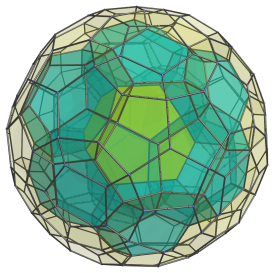
The north pole cell is rendered in yellow, with the 12 dodecahedra surrounding it in cyan. The cells in the layer surrounding that are in yellow. For clarity, we have omitted the cells lying on the far side of the 120-cell. The equatorial cells are not visible, because they also project to the far side of the 120-cell.
The same projection, under a different coloring scheme, is used to generate the background image of several pages on this site. Here is the high-resolution projection of the 120-cell used. A thumbnail of this image is shown below:
Coordinates
The coordinates of the 120-cell are all permutations of coordinates and changes of sign of:
- (2, 2, 0, 0)
- (√5, 1, 1, 1)
- (φ, φ, φ, φ−2)
- (φ2, φ−1, φ−1, φ−1)
together with all even permutations of coordinates and all changes of sign of:
- (φ2, φ−2, 1, 0)
- (√5, φ−1, φ, 0)
- (2, 1, φ, φ−1)
where φ=(1+√5)/2 is the Golden Ratio.
These coordinates give an origin-centered 120-cell with edge length 2/φ2.




